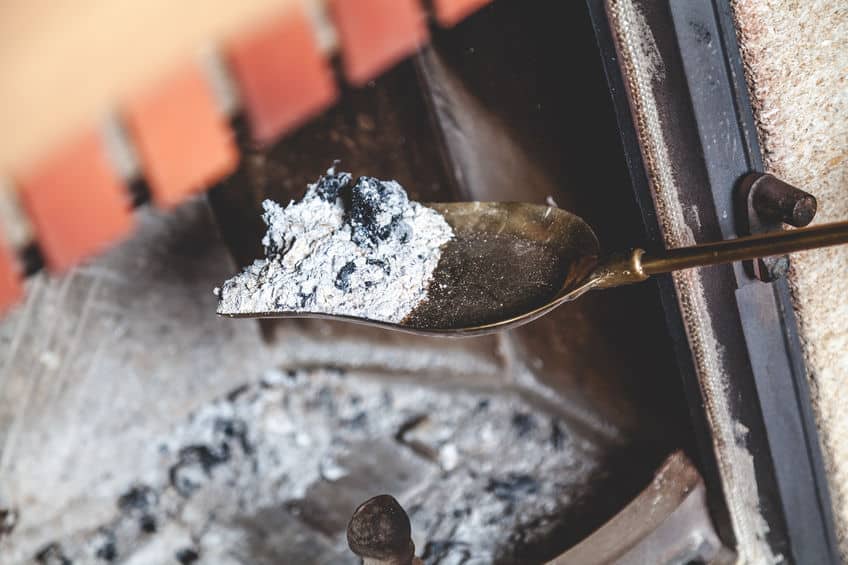A question that often comes up when talking about different composting techniques is weather or not ash can be used in compost or the garden.
The answer is yes, you can compost wood ash from your fire pit or fireplace. There are a few caveats to this however and even depending on where you live can have great impacts on how much wood ash you should be adding to your compost or garden on its own.
If you’re like me, you love having the occasional
One of the biggest warnings you will ever hear about using wood ash in and around your lawn and garden, including in your compost pile, is that ash is very alkaline compared to most items you normally would add.
Soil is different around the world when it comes to its acidity. Depending on where you live, a soils “pH” will differ drastically. The pH scale will measure a soil’s acidity or it’s alkalinity. The scale ranges from 0 or extremely acid to 14, extremely alkaline. 7 is neutral. There is a great page explaining Soil pH at the ESF SUNY College of Environmental Science and Forestry’s website but for the sake of our conversation here, just know that most plants like a slightly acidic soil of 6.5.
Before we get into using wood ash in the compost or on its own in the garden, it is pretty important that you have an understanding of your garden’s pH. This really will only pertain if you are planning to use a large amount of wood ash or on a regular basis in the garden and pile.
The reason for this is that wood ash, from the most common hard-woods and some soft-woods is naturally very alkaline. Like somewhere in the 9 or higher range of pH. When adding a substance of this alkalinity to your compost pile, let alone your garden itself, it can drastically change the soil’s pH without question.
Like I mentioned earlier though, if you’re only using a small amount, like under a pound or two in an entire season’s worth of composting, you will most likely be fine as the volume of other materials in the pile over that time will dilute the alkalinity down to normal 6.5 to 7.
If you plan on testing your soil, which I recommend if you are going to be adding ash regularly to your composting regimen, I suggest getting a simple soil pH testing kit. These kits are affordable and usually can be used several times if not indefinitely. For a list of the ones that I have used in the past or that I recommend, check out the soil test kits at our Tools For Composting page.
Now don’t let me scare you here about adding wood ash to your compost pile. In most cases, the addition of some ash every now and then will usually help and depending on what your soil’s pH ends up being, the benefits of it will far outweigh the risks.
Some cautionary advise. I never have had any reason to add wood ask directly to the garden or lawn directly. I have always added it to my compost and let it break down there. The reason is that I’d prefer that it break down in the compost pile and let the minerals dilute there and then add that to the garden later. This reduces the risk of drastically increasing your soil’s pH in any one area in the garden.
Plants That Do Not
Like Highly Alkaline Soil
With all that said, some plants that probably really won’t need any addition of
wood ash or highly alkaline compost will include…
- Azaleas
- Rhododendrons
- Chrysanthemums (mums)
- Marigolds
- Daffodils
- Hydrangeas
- Blueberries
- Magnolia Trees
- Holly Shrubs
If your yard contains a large amount of these plants, and they seem to be doing very well, you may want to hold back on adding any wood ash to the compost.
What Makes Up Good
Wood Ash To Add To The Compost Heap?
The best kind of wood ash to use is from any of the good hard woods such as Oak,
Maple, and Birch. Sometimes you might get your hands on some Cherry or Walnut
to add to the fire as well.
Second best to the pit would be your softwoods like pine and fir. Most people avoid burning these because they burn quickly and are very sappy, which tends to cause more sparks than normal. Sometimes not a good thing.
Woods to avoid using for adding to your compost would include anything that has been treated or painted. These have chemicals that leave a chemical residue after burning that can get transferred to the garden and eventually affect your plants. Besides, burning these things aren’t good for your health either.
What Makes Wood Ashes So Good?
Wood ash is very vital to the garden when used properly, that before the times of fertilizers, it may have made the difference between an o.k harvest versus a great bounty on the homestead.
Wood ashes contain many micronutrients and minerals that greatly benefit your vegetables and plants at home. Some of these elements include…
- Calcium
- Potassium
- Magnesium
- Phosphorus
- Manganese
- Chromium
- Copper
- Nickel
- Zinc
The above list is in order of highest to lowest of its concentration within the wood ash.
Calcium, for example, makes up about 15% of the total mass within the ash which is by far the most prevalent mineral within.
However, if you were to use ground limestone, which is commonly used to raise a soils alkalinity in the garden, as a comparison. The limestone has about a 31% concentration of Calcium.
A good resource on this matter is a University of Georgia page on using wood ash for as a soil amendment.
Using Your Wood Ash
When it comes to composting on a regular basis, many people have a “multi-stage” composting system in place where they have several bins or piles of compost at different stages of completeness. In these situations, you can add small amounts of ash to the first stage of the pile every month or so during the active season Spring to late Summer). This can be mixed in with all your vegetable scraps, grass clippings and carbon materials.
As your pile progress through to the next stage or two, the wood ash will gradually break down with everything else and be thoroughly mixed in by the time the compost is complete.
If you are just running a single compost pile or bin you may want to spread the amount of time you add ashes to the pile or just reduce the volume you throw in. If you actively attend the compost pile, adding and mixing up the materials on a regular basis, considered a “hot” compost pile, you should also be ok with once a month or so.
If the compost you are working on is rarely used, and is considered to be a “cold” compost pile, you should really only add the wood ashes in the fall or late summer. Or, after you have used any compost from the pile for the last time that year.
This way, the ash will have a chance to break down slowly in the pile over time.
Using Wood Ash on its Own In the Garden
If you plan on using the wood ash on its own, without composting, which I don’t recommend in most cases. I would suggest that you use a soil pH kit for sure in this case.
Once you know exactly where in the yard or garden that the soil levels are much too acidic for the plants in that area to thrive, you can add a small amount around plants or on the soil.
Generally, you don’t want to have the wood ash in direct contact with the roots of plants so don’t mix it directly in against the plants. Instead, leave it on the top of the soil and let nature gently bring the minerals down to the plant with regular watering and natural absoption.
If the soil in your garden is in drastic need for amendment, either more alkaline or more acidic, you can find some suggested products at the Tools For Composting page.
Whether you decide to use wood ash in your garden or in your compost pile, if done correctly, you will find that it is a fantastic way to help your plants thrive and in the case of vegetables, you could get some great tasting and large ones for years to come.

